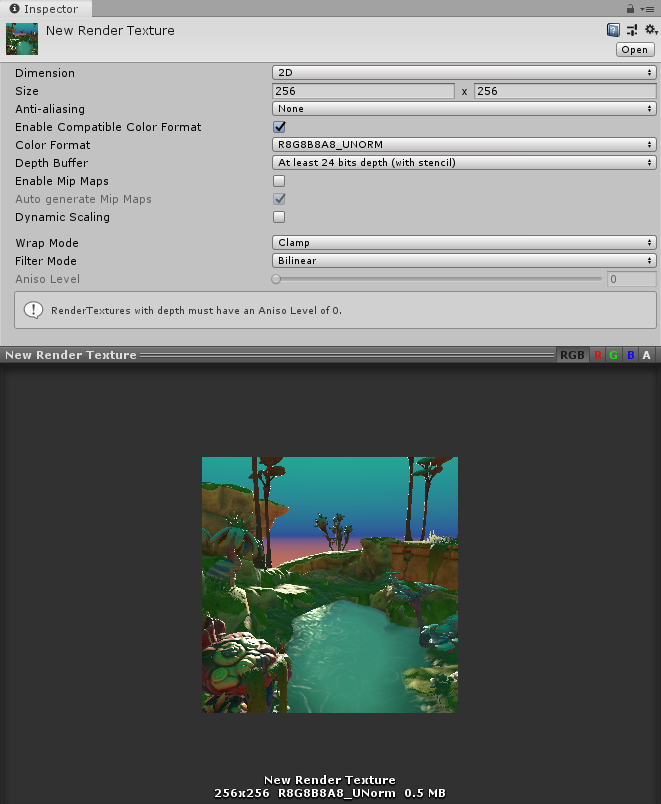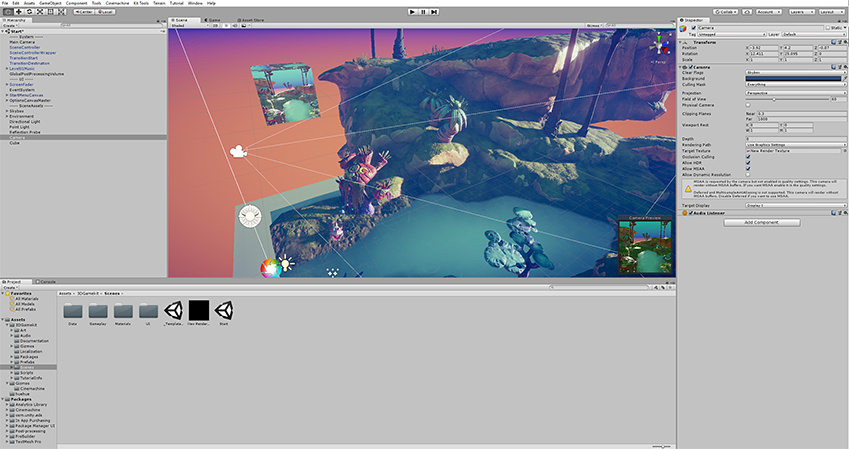Unity Draw Texture on Plane
Streaming Controller component
Render Texture
A Render Texture is a blazon of TextureAn image used when rendering a GameObject, Sprite, or UI element. Textures are often applied to the surface of a mesh to give it visual item. More info
See in Glossary that Unity creates and updates at run time. To use a Return Texture, create a new Render Texture using Assets > Create > Render Texture and assign information technology to Target Texture in your Photographic cameraA component which creates an image of a particular viewpoint in your scene. The output is either drawn to the screen or captured as a texture. More info
Run across in Glossary component. So you can use the Render Texture in a Cloth An asset that defines how a surface should be rendered. More info
See in Glossary just like a regular Texture.
Properties
The Return Texture inspector A Unity window that displays information about the currently selected GameObject, nugget or project settings, assuasive yous to inspect and edit the values. More info
Come across in Glossary is similar to the Texture Inspector.

The Render Texture inspector displays the current contents of Render Texture in realtime and can be an invaluable debugging tool for furnishings that use render textures.
| Property: | Function: | |
|---|---|---|
| Dimension | The dimensionality (type) of the render texture. | |
| 2D | The render texture is ii-dimensional. | |
| Cube | The render texture is a cube map. | |
| 3D | The render texture is iii-dimensional. | |
| Size | The size of the return texture in pixels The smallest unit in a computer paradigm. Pixel size depends on your screen resolution. Pixel lighting is calculated at every screen pixel. More info See in Glossary . Y'all can but enter power-of-two values, such as 128 and 256. | |
| Anti-Aliasing | The number of anti-aliasing samples. You tin can select None, 2 samples, four samples, or 8 samples. If you select None, Unity does not apply anti-aliasing. | |
| Enable Compatible Color Format | Enable this checkbox to make Unity utilize a uniform format to the render texture if the defined Color Format is not supported by the platform. | |
| Color Format | The color format of the return texture. | |
| Depth Buffer | The format of the depth buffer. You can select No depth buffer, At least sixteen bits depth (no stencil), or At least 24 bits depth (with stencil). The stencil buffer is a full general purpose buffer that allows you to store an additional unsigned 8-bit integer (0–255) for each pixel drawn to the screen. | |
| Enable Mip Maps | Bank check this box to brand the render texture generate mipmaps. | |
| Car generate Mip Maps | Check this box to automatically fill up the generated mipmaps with relevant data. If you don't enable this, you lot'll accept to use the GenerateMips office to fill those mipmaps manually. Alternatively, choose which mip to return into when y'all telephone call the diverse SetRenderTarget functions. For more information most the SetRenderTarget functions, see Graphics.SetRenderTarget and Rendering.CommandBuffer.SetRenderTarget. | |
| Dynamic Scaling | Check this box to let dynamic resolution scaling resize the render texture. If you don't enable this, the return texture maintains the same size regardless of the Dynamic Resolution A Camera setting that allows you lot to dynamically scale individual render targets, to reduce workload on the GPU. More info See in Glossary setting. | |
| Wrap Mode | Controls how the texture is wrapped: | |
| Repeat | Tiles the texture to create a repeating pattern. | |
| Clamp | Stretches the edges of the texture. This is useful for preventing wrapping artifacts when you lot map an image onto an object and you don't want the texture to tile. | |
| Mirror | Tiles the texture to create a repeating blueprint that mirrors the texture at every integer boundary. | |
| Mirror Once | Mirrors the texture once, and and then falls dorsum to clamping. | |
| Per-axis | Lets you lot set different wrap modes for the U centrality and the V axis. The available options are besides Repeat, Clamp, Mirror and Mirror Once. For example, when you utilize latitude-longitude surroundings maps for reflection probes A rendering component that captures a spherical view of its surroundings in all directions, rather like a camera. The captured epitome is then stored every bit a Cubemap that tin can be used by objects with reflective materials. More info See in Glossary , it is useful to have Clamp on the vertical coordinate (V centrality), but Repeat on the horizontal coordinate (U centrality). | |
| Filter Mode | Controls how the sampling of the texture uses nearby pixels. The options are: | |
| Point | Uses the nearest pixel. This makes the texture appear pixelated. | |
| Bilinear | Uses a weighted average of the 4 nearest texels. This makes the texture appear blurry when you magnify it. | |
| Trilinear | Uses a weighted average of the 2 nearest mips, which are bilinearly filtered. This creates a soft transition between mips, at the cost of a slightly more blurry advent. | |
| Aniso Level The anisotropic filtering (AF) level of a texture. Allows yous to increment texture quality when viewing a texture at a steep angle. Good for floor and footing textures. More info See in Glossary | Anisotropic filtering level of the texture. This increases texture quality when you view the texture at a steep angle. Practiced for floor, basis, or road textures. | |
Case
To create a live loonshit camera in your game:
- Create a new Render Texture nugget using Assets >Create >Render Texture.
- Create a new Photographic camera using GameObject > Camera.
- Assign the Render Texture to the Target Texture of the new Camera.
- Create a new 3D cube using GameObject > 3D Object > Cube.
- Drag the Return Texture onto the cube to create a Cloth that uses the return texture.
- Enter Play Mode, and find that the cube'due south texture is updated in real-time based on the new Photographic camera'southward output.

-
2019–04–11 Folio amended
-
Render Texture inspector changed in Unity 2017.2
-
Ability to use any GPU format to Return Textures added in Unity 2019.1
Streaming Controller component
Source: https://docs.unity3d.com/Manual/class-RenderTexture.html
0 Response to "Unity Draw Texture on Plane"
Postar um comentário